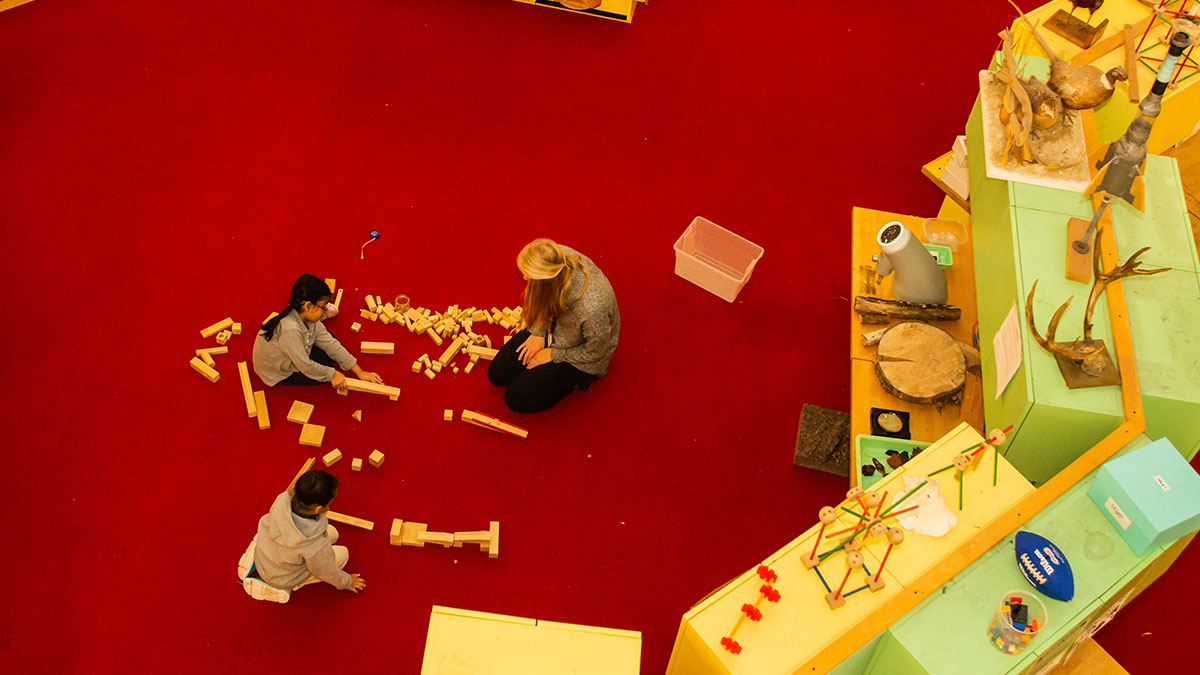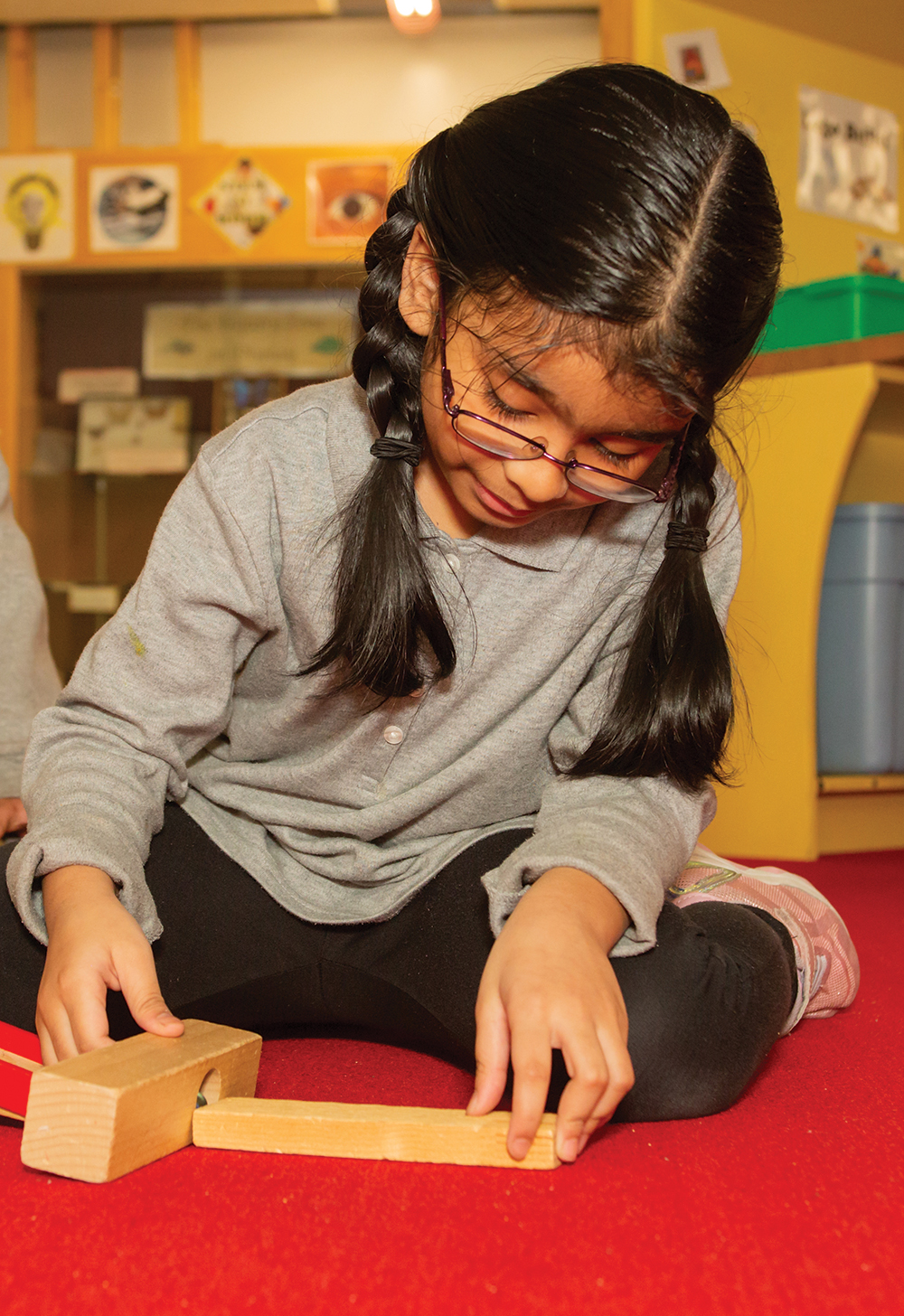Inquiry Zones
Pathways to the science and engineering practices
Science and Children—February 2020 (Volume 57, Issue 6)
By Bill Lindquist, Bryna Wiens, Robyn Char, Leah Mark, and Joshua Baumgartner

Dynamic, engaging centers help learning come alive with a sense of wonder. This stimulates imagination and curiosity in a way that builds science and engineering practices as students actively engage through the process of inquiry. Learning centers “give children the opportunity for wonder, mystery, and discovery…that speaks to young children’s inherent curiosity and innate yearning for exploration” (Heard and McDonough 2009, p. 8). To develop proficiency in the practices of science, students need to be actively engaged in the doing of science.
Crossroads Elementary School in Saint Paul, Minnesota, was designed and built physically and pedagogically with an “Inquiry Zone” located in the heart of the school. This collection of 80 learning centers provides a pathway for all students to pursue their own scientific interests. Students make weekly visits to the Inquiry Zone to interact with these learning centers. Facilitated in a collaborative effort between the classroom teacher and a STEM Fellow, students conduct their own inquiries into science and engineering. Centers are constructed with a primary focus on developing science and engineering practices. It is the acquisition of these practices that enable students to independently pursue their own interests. The STEM Fellow is a Hamline preservice teacher candidate selected for their ability to work in this unique space. The fellowship occurs in the semester immediately prior to student teaching. In this article, we describe the background and rationale of our development and use of a school-based Inquiry Zone and offer ideas and encouragement for developing similar Inquiry Zones in your elementary classroom.
Background
Crossroad’s Inquiry Zone is a 30’ × 80’ space at the center of the school divided into small, inviting, and intimate spaces created by an array of fabric-covered walls enclosing 80 workstations. These spaces are intentionally designed to draw attention, slow activity, and encourage students to focus on the materials of their chosen center. Each center allows full engagement for students of any age and skill level. Instructions are intentionally simple and sparse, serving to facilitate an open-ended inquiry experience rather than a prescribed set of directions to follow. Sufficient materials are on hand for each student to elaborate on their investigation, yet limited to prevent students getting lost in an endless morass of possibilities. The environment is designed to support kids’ creativity in the use of objects, ideas, and processes through experimentation, construction, and play. A sense of history of previous ideas and ongoing investigations are present, inviting students to enter into dynamic living investigations of science. Students are able to add on to developing ideas, challenge ideas presented, or begin anew.
Facilitating the Work
An ongoing challenge in the Inquiry Zone has been the need to be alert to ideas for new centers. The centers that work well have the ability to capture and hold interest; allow independent engagement with materials; and are built solid enough to hold up to the demands of continuing student use. We peruse museums, science education catalogs, science stores, and NSTA science activity books. We generally land on an idea smaller than what you would see at a museum but bigger than published activities. The best stations are ones that are handmade using commonly available materials. Each center has a poster inviting the student to work. It has a captivating title, an investigative focus question, directions to enter the investigation, and associated standards.


Prior to coming to the Inquiry Zone, the classroom teacher meets with her students to coordinate which center students will work with. Students arrive at the Inquiry Zone and are met by the Inquiry Zone STEM Fellow. They gather on the carpet while the Fellow reminds them of the expectations and sets the tone for the explorations ahead. Posted on the wall are the following agreements:
In the Inquiry Zone, we agree to:
- Move calmly
- Work safely
- Wonder deeply
- Gather quickly
The Fellow then passes out index cards with student names. Students move to their center and slide their card into an envelope posted at the center. This serves to anchor the students for the duration of their Inquiry Zone time. At each center, materials are contained in a box or organized on the table. Previous ideas and investigations from other students can remain in the center or be posted on the walls. Students build, modify, or expand on those ideas. Centers include guiding questions, standards, and vocabulary for both students and facilitators. The classroom and Inquiry Zone teachers circulate throughout the space to facilitate student experiences through asking questions, prompting deeper investigation, and probing for meaning. At closing time, a bell is rung as a signal it is time to clean up. Students return to the carpet as a whole group. They are expected to gather their thoughts in a quiet reflection time or share their findings with a partner. We may ask, “What went well in your investigation? What was challenging? What might you do next?” Students may return to the same center to continue an investigation they have begun or move on to another.
An Inquiry Zone can be as large as the central space we enjoy or as small as a table nestled into a corner of a classroom. Look for ways to bring the idea into your setting. Your school might have an empty classroom to set up as a fully functioning Inquiry Zone. You might transform a portion of the cafeteria for two weeks in January. Or you might plan for a dedicated Inquiry Zone space in your classroom. Collaborating with other teachers allows you to create more centers and rotate them among your classrooms. Over time, these unique spaces will make for rich learning for your students. This promotion of inquiry may help us reach the goal of establishing learning environments that “exploits the natural curiosity of children so that they maintain their motivation for learning not only during their school years, but throughout life” (Yager 2009, p. ix).


